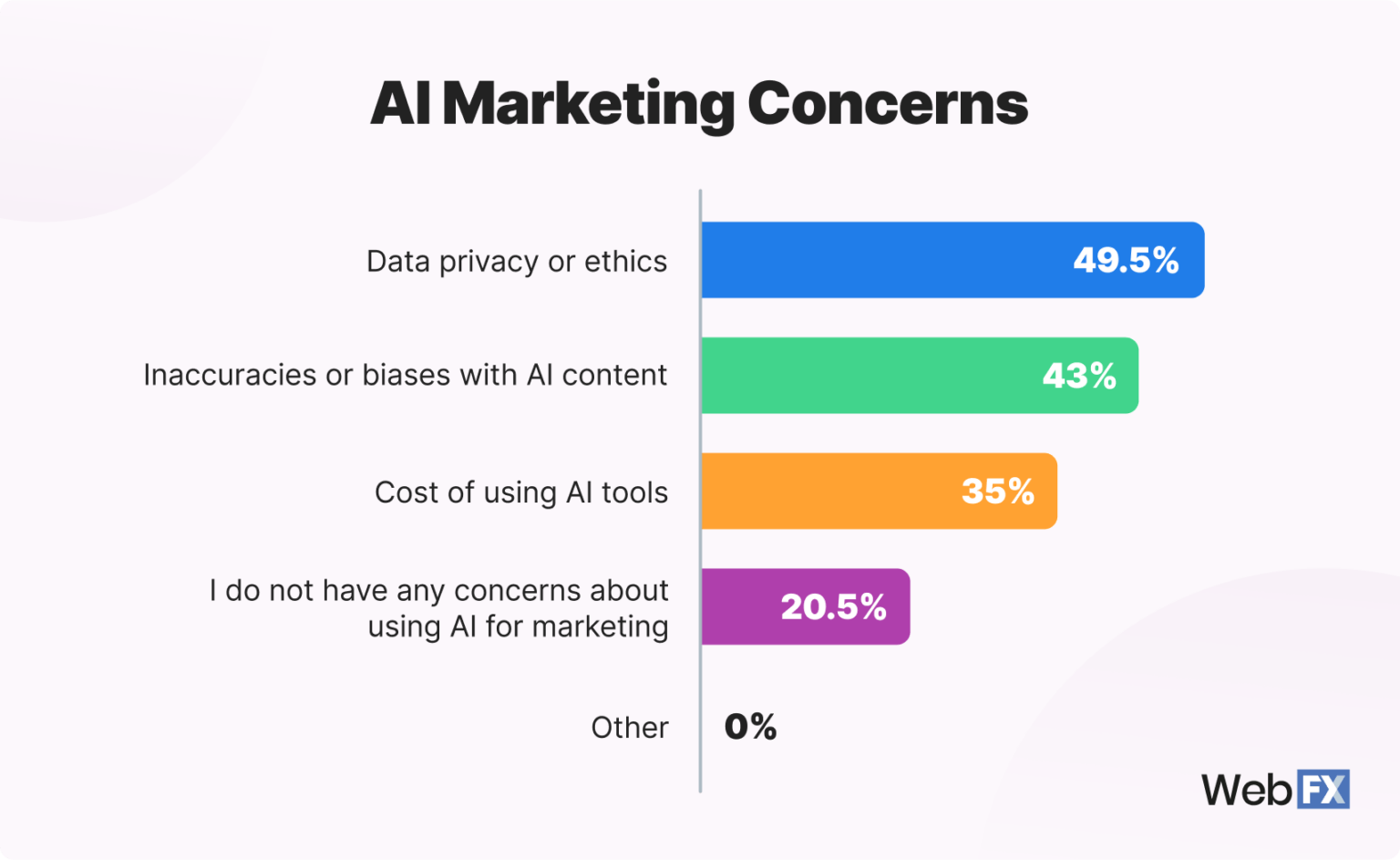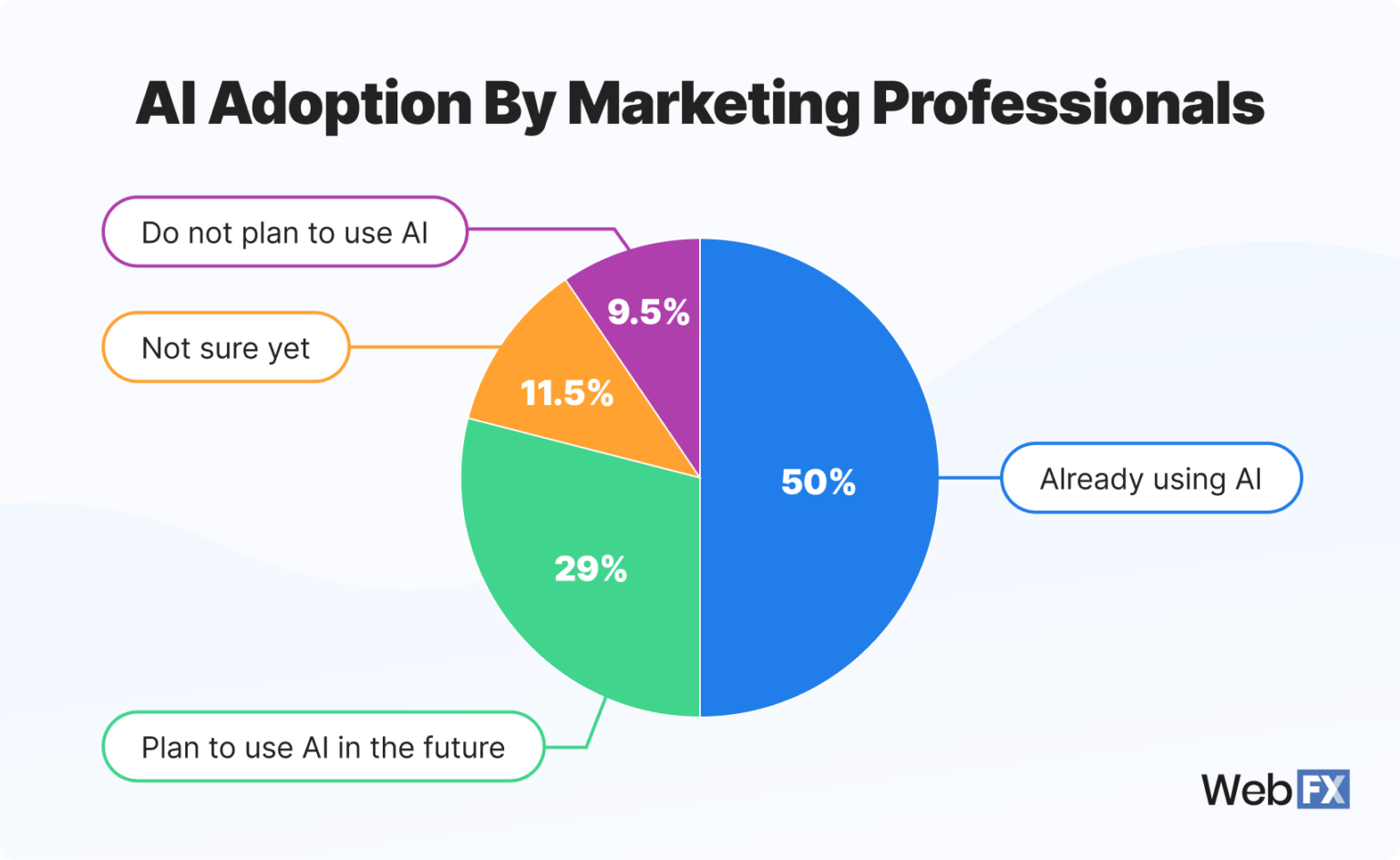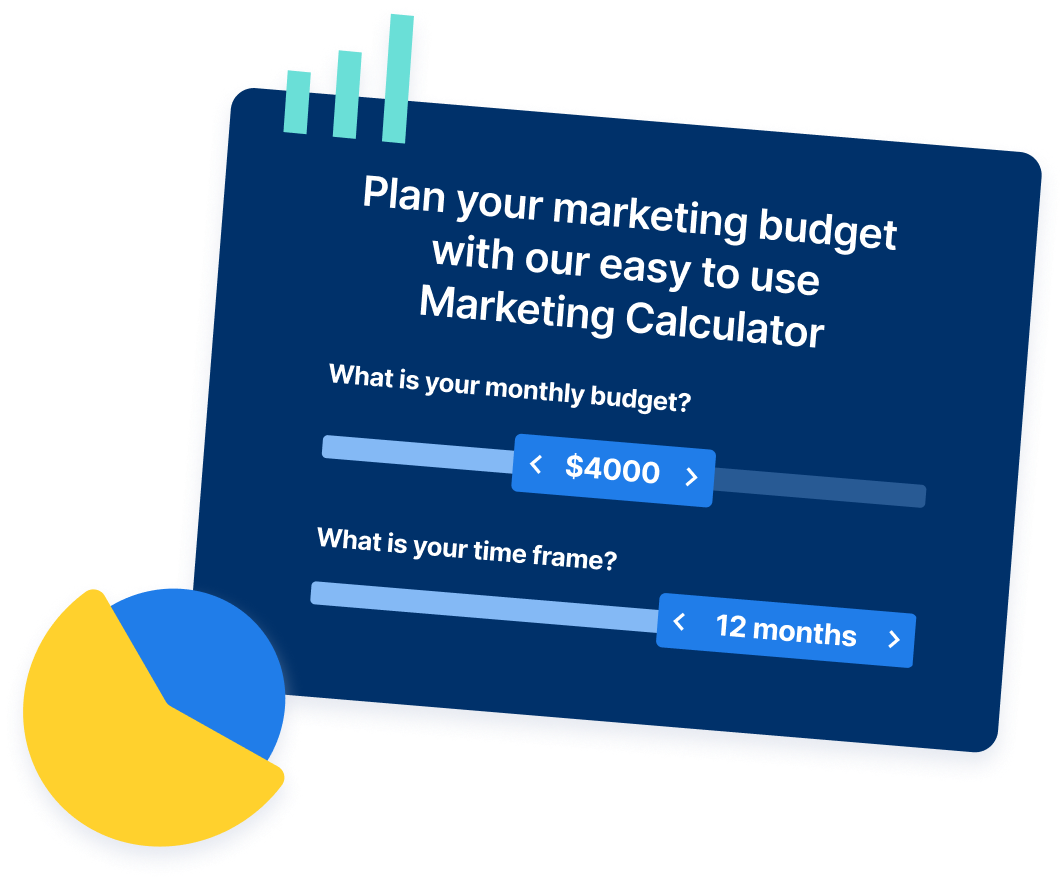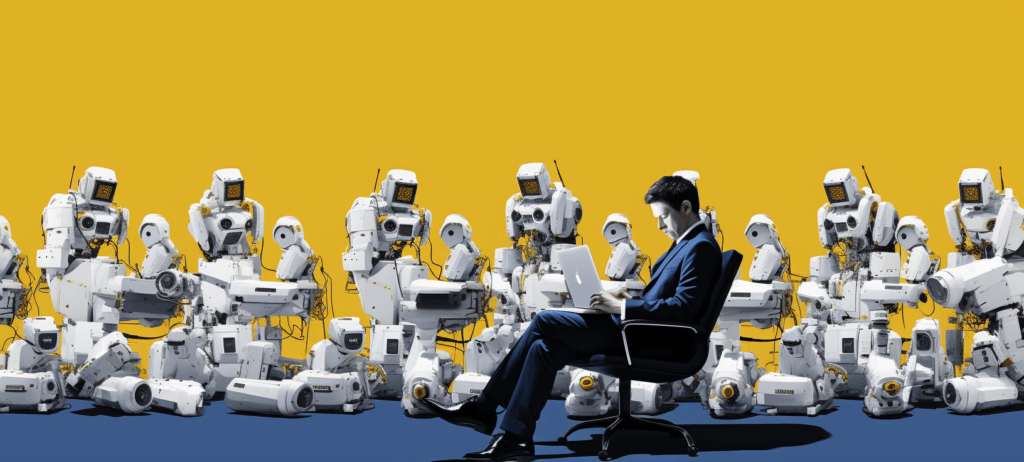-
 Published: Nov 1, 2024
Published: Nov 1, 2024
-
 6 min. read
6 min. read
-
 Emily Carter, M.S.
Emily Carter, M.S. Sr. Content Team Lead
Sr. Content Team Lead
- Emily leads the FX content team, along with strategy, implementation, and evaluation for WebFX’s key revenue channels. She holds an M.S. in digital marketing, and her work has been featured by Social Media Today, Campaign Monitor, Reader’s Digest, and more. In her free time, she enjoys hiking, road trips, and exploring new cities. @emcarter16
When it comes to artificial intelligence in business, the benefits start when companies learn how to use AI effectively at the organizational level. With that kind of scale, businesses can see real change in their operations, from bigger marketing returns to higher close rates to better client satisfaction.
Looking to see that kind of growth at your organization? Then, keep reading to learn how businesses can use AI effectively in 2025 and understand the common concerns business leaders have about using artificial intelligence in the workplace.
What are the benefits of using AI in business?
At an organizational level, the benefits of using AI in business include:
- Creating alignment between departments: Business areas, like marketing and sales, often operate separately. With artificial intelligence, companies can create a bridge between these departments for sharing data, aligning efforts, and more.
- Streamlining tasks and saving time: Across industries, organizations can use AI to save time. Whether it’s automating meeting notes, candidate screening, or compliance checks, there are industry- and task-specific AI tools to help teams get their time back.
- Enhancing decision-making: Departments and organizations can use platforms like ChatGPT and Claude to make more informed decisions. Platforms like these can analyze large datasets, provide deeper risk assessments, and more.
- Optimizing costs: Most conversations around AI focus on costs. While some organizations see AI as a cost-cutting measure, it’s best used for optimizing costs — meaning team members can focus their time (and the organization’s money) on bigger initiatives.
- Improving competitive advantage: When all the benefits of using AI in business come together, organizations receive a competitive advantage in the marketplace because the business uses its time and resources better than the competition.
What are some concerns about using AI in business?

However, there are concerns about using AI in business, the biggest being:
- Data privacy or ethics (49.5%)
- Inaccuracies or biases with AI content (43%)
- Cost of using AI tools (35%)
Only 20.5% of businesses cite zero concerns. Companies should have a healthy skepticism toward AI, though. That skepticism helps organizations (and team members) spot inaccuracies and biases and ensure the AI platform performs as expected.
It’s also why using AI in business isn’t about cutting costs but optimizing costs. You need experienced team members to monitor, judge, and (if needed) correct an AI model’s output to ensure it complies with organizational and industry standards.
Are businesses using AI?
Yes, most businesses are using AI. Based on our research, we found the following:
- Already using AI (50%)
- Plan to use AI in the future (29%)
- Not sure yet (11.5%)
- Do not plan to use AI (9.5%)
If you haven’t experimented with using AI, consider getting started now to avoid falling behind.
What are the most common use cases for AI in business?
The most common use cases for AI in business center on the following departments:
| Department | Use cases |
| Marketing |
Idea generation Content creation and translation Personalization Social listening Performance analysis |
| Sales |
Lead scoring Outbound sales Personalization Upsells and/or cross-sells Sales forecasting |
| Customer support |
Chatbots Sentiment analysis Support ticket management Personalization |
| Operations |
Risk assessments Predictive analytics Data entry Process automations |
| Accounting |
Payroll and billing Data entry Fraud monitoring and/or detection Compliance monitoring and/or audits |
| Recruiting |
Candidate or resume screening Interview scheduling Personalization Bias reduction |
| Supply chain |
Inventory management Demand forecasting Risk management Supplier scoring Logistics network optimization |
7 examples of how businesses can use AI
Get insights into how businesses can use AI with these examples:
1. Marketing: Personalization
Personalization is more than [Company Name] with AI. With generative AI, marketing teams can create messages, experiences, and offers that resonate with users and drive the desired action, like purchasing a product. AI content personalization, when implemented properly, is revolutionizing how brands engage with their customers
In an example from Ticketek, an Australian ticketing and technology company, the brand used Amazon Personalize to shift its email newsletters from state-based personalization to interest-based personalization, resulting in:
- 200% improvement in purchase rates
- 49% improvement in the volume of tickets sold per newsletter
2. Sales: Lead scoring models
Timing is everything — especially for sales teams. When sales teams can prioritize their time and reach out to the right lead at the right moment, it can have a tremendous impact on the organization and its bottom line.
Leveraging AI for lead generation and scoring can have a big impact.
A software company, Salesloft (formerly known as Drift), used MadKudu for this purpose.
With MadKudu, the Salesloft team discovered that 90% of their pipeline came from 25% of their leads. Based on this data, MadKudu could score leads automatically, which enabled the Salesloft team to prioritize their outreach efforts.
3. Customer support: Chatbots
Chatbots have become vital support team members, whether providing pre-determined responses to common questions or gathering initial information before routing a customer to a team member. AI, however, has changed what chatbots can do for businesses.
Databox, a business analytics platform, used Fin AI from Intercom to make its support documentation actionable. Instead of team members searching the broad library to answer user questions, Fin AI could find, summarize, and share this information with clients.
For Databox, the results were dramatic:
- 50% increase in team productivity
- 40% increase in new revenue via support
4. Operations: Predictive analytics
With the power to predict internal and customer needs, organizations can optimize their costs and time. In this example of how businesses can use AI, the Government of Jersey used IBM’s AI solutions to predict equipment maintenance and inventory needs to serve its residents better.
5. Accounting: Fraud detection
Fraud detection is critical for financial institutions — especially as more transactions occur online. That’s why FinSecure Bank adopted an AI-powered fraud detection system, which reduced fraudulent activities by 60%.
6. Recruiting: Resume screening
The volume of applications vs. the number of recruiters can halt an organization’s hiring efforts. For a U.S.-based professional services firm, this was the case. The company received thousands of applications for government roles that required high-security clearances.
In response, the company partnered with Withum, an advisory firm, to develop an AI-powered solution for gathering essential information from applications (while meeting data privacy requirements) for later review.
The results included:
- Saving time by eliminating manual data entry
- Increasing time to close
- Meeting data privacy and security requirements
7. Supply chain: Inventory management
With better inventory management, businesses can optimize costs, space, and more.
In this example of how businesses can use AI, Walmart used an AI-powered inventory management system to help the company deliver what users needed (and when they needed it) during the holiday season.
While Walmart hasn’t shared specific results from using this platform, it has emphasized how it can predict future needs based on the weather, local demographics, and economic trends for its physical and online stores.
What are the most common AI tools businesses use?
The most common AI tools businesses use include free tools like:
- ChatGPT
- Claude
- Gemini
- Deep Research
- Meta AI
More advanced platforms include:
- IBM Watson
- Tableau AI Analytics
- TensorFlow
Start using AI in your business with TeamAI
You’ve discovered how businesses can use AI to improve operations, revenue, and growth. Now, start using AI, from ChatGPT to Claude to Gemini, with TeamAI — the AI platform built for teams and organizations like yours.
Start using TeamAI for free now!

AI Workspace for Business Teams
Imagine an AI workspace where you can collaborate with team members, share prompts, and leverage personas for generative AI.
Empower My Team with AI-
 Emily leads the FX content team, along with strategy, implementation, and evaluation for WebFX’s key revenue channels. She holds an M.S. in digital marketing, and her work has been featured by Social Media Today, Campaign Monitor, Reader’s Digest, and more. In her free time, she enjoys hiking, road trips, and exploring new cities.@emcarter16
Emily leads the FX content team, along with strategy, implementation, and evaluation for WebFX’s key revenue channels. She holds an M.S. in digital marketing, and her work has been featured by Social Media Today, Campaign Monitor, Reader’s Digest, and more. In her free time, she enjoys hiking, road trips, and exploring new cities.@emcarter16 -

WebFX is a full-service marketing agency with 1,100+ client reviews and a 4.9-star rating on Clutch! Find out how our expert team and revenue-accelerating tech can drive results for you! Learn more
Try our free Marketing Calculator
Craft a tailored online marketing strategy! Utilize our free Internet marketing calculator for a custom plan based on your location, reach, timeframe, and budget.
Plan Your Marketing Budget
Table of Contents
- What are the benefits of using AI in business?
- What are some concerns about using AI in business?
- Are businesses using AI?
- What are the most common use cases for AI in business?
- 7 examples of how businesses can use AI
- What are the most common AI tools businesses use?
- Start using AI in your business with TeamAI

Proven Marketing Strategies

Proven Marketing Strategies
Try our free Marketing Calculator
Craft a tailored online marketing strategy! Utilize our free Internet marketing calculator for a custom plan based on your location, reach, timeframe, and budget.
Plan Your Marketing Budget
What to read next





